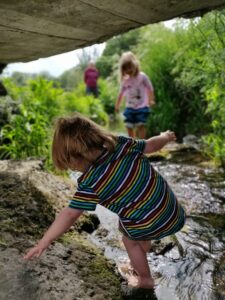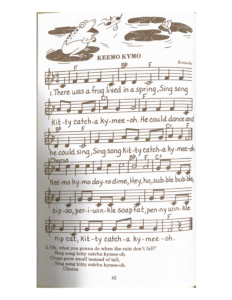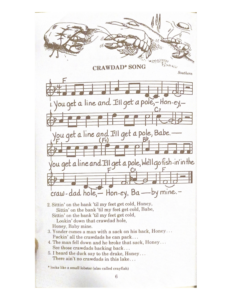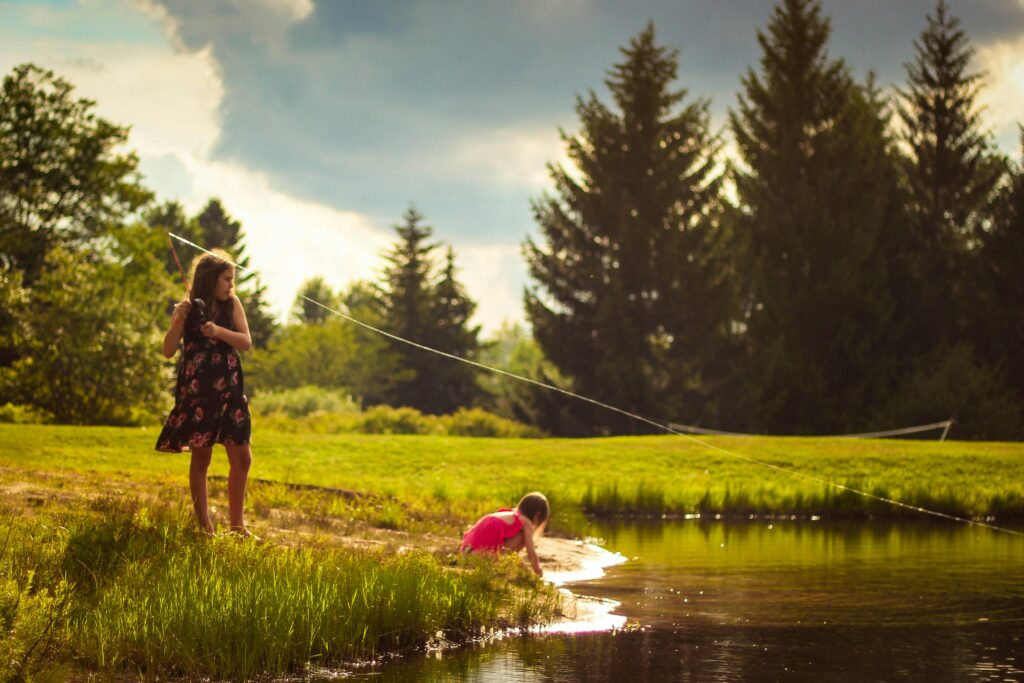June 2024
This blog has been written by Acacia Moore, the Director of Online Courses and apprenticing Executive Director for LifeWays North America.

This May, I completed a three year Curative Educator’s training from Robyn Brown, founder of The Mulberry Center for Curative Education. For these past three years, I have taken up the study of how Curative Education fits into early childhood with great sincerity, contemplating on interwoven themes of the incarnating child, the foundational senses, overcoming karma and Rudolf Steiner’s curative lectures. Most importantly, I have eagerly experimented with the practical applications of what I have learned; and one major area of influence has been within the realm of movement and games.
Previous to finding Robyn’s training and book, I had spent a few years already playing around with the traditional format of a Waldorf circle time. To begin with, in a LifeWays program, just as in most homes, it doesn’t feel quite so natural to hold this traditional format. Nonetheless, there is also nothing wrong with it. It can be very joyful and nourishing, and the school I was working at held circles in class and for festivals. Though, what I had begun to recognize in an increasing number of children in my group was that they were actually having so much difficulty with imitating gestures, or managing the whole of it without overwhelm that it no longer made much sense to continue attempting it in the same way. What I accomplished was a good start, slowing down the circle and working with one or two verses/songs/games at a time and often gradually building up to the full circle.
A few years later, freshly empowered by my studies with Robyn, I began changing things up again. In my current program, I no longer hold a formal circle time. Instead we weave songs, fingerplays, and verses into transition times, and have movement games most mornings. About once weekly, those movement games consist of obstacle courses that the children set up. To begin, I bring a premeditated vision of our course consisting of activities that will best serve the children in my group and verses or songs to tie in. There are a few fundamental elements from Steiner’s creative lectures that my movement activities are based upon:
- Balance
- Contraction- Expansion
- Levity- Gravity
- Movement through the three planes of space
- Bringing intentionality to movement (which often means slowing them down and maintaining a joyful but focused mood)
This is an example of a suitable one for summer time, A Morning of Fishing. It works with all the above elements and gets them into their feet, which this group really needed.
We begin with the course materials gathered on our large “meeting rug”. Funny enough, we call it our lake since first creating this movement adventure, often using the imagery of “sit upon the shore” to bring children to its periphery. We have: several large blocks for rocks, a balance beam for bridge, small pillows or silks for frogs, and a bucket of bean bags for fish.
With the children gathered, we sing one verse of a folk song, Keemo-Kymo, from Wee Sing, Fun’n’Folk; and a story to frame our game:
There was once upon a time a group of children who decided to visit the lake on a very hot summer day. Some of them wished to go swimming, others to skip rocks, but when someone cried out “let’s go fishing!”, they all agreed.
And that is just what we will do. We are taking a trip to the lake to fish. Our journey will wind over rocks on the creek, over a bridge, past the frogs on the shore and finally round the lake. Let’s set up our course together.
Then, I guide them along to setting up the course with our materials, using questions as often as possible, directed towards the older children, but finding places for the younger ones to help as well. *It is helpful to mention here that I have children in my class from 3.5- 6.5 years old.
As the children begin moving through the obstacle course, I select someone I know can make their way with their best effort. I use imagery to describe how we will move, asking a question or two of the older children (around five or above), but allowing the youngest to imitate as they can.
The creek is rushing quickly, how must we move over the rocks so we don’t get swept away? They move slowly, carefully stepping to balance upon each rock. If an older child rushes and steps into the “water”, I might say, “Oh, you got all wet! Let’s step back to the bank and try again.” If they are a child who has not really come into their body, I might ask, too, “How will you move your body so you don’t fall in again?
I can say similar things at the other obstacles to help them move with intent. I don’t pester every child, every time they don’t quite make it. I’m aiming for the long game here, so I might ask something once or twice of the older children who need to slow down and move more intently.
The creek has become a river and we must use the bridge to cross it. The bridge is very old and there are barn swallows who have made nests in the rafters who swoop down to tease the visitors. How will we cross the bridge safely and keep an eye out for the birds? They hold their arms out like a bird, walk slowly with a “heel-toe kiss”, and keep eyes up. This is a kind of walking we have practiced before on the balance beam using different imagery.
Oh my, the meadow surrounding the lake is spotted with frogs! How will we make our way around the shore to sit for fishing? They hop over each silk until they make their way all the way back round to sit down at their spot on the shore.
Now, gathered around the lake, we sing another folk song, the Crawdad Song.
Then I guide them into fishing…
When the children arrived at the lake, they took out their long fishing poles, baited their hooks with their wiggly worms and plopped them into the water to catch some very hungry fish! As I am speaking, I untuck one leg, tug at my toes, extend it out long and wiggle my toes. Let’s make sure there is enough fish for everyone! And they all fish for the bags.
Once everyone is done, I ask how many they caught, then invite them to toss their fish into our ice bucket to keep fresh until we cook them. This inspires some to move directly to cooking their fish in play once we all leave “the lake.” They take turns tossing their bean bags into the bucket from where they are sitting, and we close with this classic nursery rhyme.
1, 2, 3, 4, 5
I caught a fish alive.
6, 7, 8, 9 10
Then I put him back again.
Why did you put him down below?
Because he bit my finger so
Which finger did he bite?
The little one on the right.
Once the process of creating obstacle courses came to live in their habit lives, the designs and manifestations came almost entirely from them. I participated by directing some of their choices when safety became an issue, or if things were steered in a mischievous direction. When the latter occurred, it was best that I stepped in to bring a centering and slowing quality to the course that would guide them back into their purposeful selves. The songs and verses might come later, I might have one or two in my back pocket to apply to the mix, or we would make something up!
When I first began working with these indications for movement, I wondered about how it seemed to misalign with some principles of early childhood. Would I be addressing the children too directly, too often and compromising the “dreamy state” from which they are imitating? I have to further question, though, how much good it does to keep allowing them to float along if they are demonstrating an inability to imitate, if there is clearly something hindering their ability to embody themselves enough to fully develop their sense of self-movement. Not everyone has these challenges, but more often than not there are many in my groups who do.
What I learned through this exploration, and with guidance from Robyn, is that addressing the children with moderation and with questions that direct them within themselves and their own movement is not the same as over-intellectualizing them. I am not supplying them with a running sportscast of their movements. Most often, I am actually quiet and holding space for the whole group to feel joyful but reverential as I happily observe them. Furthermore, they are also given opportunities to imitate my gestures during songs, finger plays and intentional movement throughout the day’s activities.
Contrary to any initial concerns, the children seemed to be coming into their bodies more readily and quickly than what I had experienced with children in my past groups. Moreover, I find it has had the opposite effect of “waking them up”. Instead, over the course of the last two years, I witnessed a positive effect on their play, which they entered more deeply and imaginatively, being so comfortable within their own skin. And lastly, I loved to see how invested in these movement activities because of how much it was living in them instead of me.
Finally, when a LifeWays certificate training student came to observe in my classroom recently, she remarked at the end of her day that the way we weave songs, games and verses throughout the day felt natural and accessible to her. In fact, she said, it felt very much like home.
Wishing you the best on your movement adventures!
Acacia
A Morning of Fishing: A Curative Movement Game

With the children gathered, begin with the first verse to this song;

Then begin your story to frame the game
There was once upon a time a group of children who decided to visit the lake on a very hot summer day. Some of them wished to go swimming, others to skip rocks, but when someone cried out “let’s go fishing!”, they all agreed.
And that is just what we will do. We are taking a trip to the lake to fish. Our journey will wind over rocks on the creek, over a bridge, past the frogs on the shore and finally round the lake. Let’s set up our course together.
Guide the children into setting up the course as you envisioned it in your space. I use the following materials: several large blocks for rocks, a balance beam for bridge, small pillows or silks for frogs, and a bucket of bean bags for fish.
Now begin moving over it, guiding the older children on occasion to move with intention
The creek is rushing quickly, how must we move over the rocks so we don’t get swept away?
The children move slowly, carefully stepping to balance upon each rock.
The creek has become a river and we must use the bridge to cross it. The bridge is very old and there are barn swallows who have made nests in the rafters who swoop down to tease the visitors. How will we cross the bridge safely and keep an eye out for the birds? The children hold their arms out like a bird, walk slowly heel-to-toe and keep eyes up.
Oh my, the meadow surrounding the lake is spotted with frogs! How will we make our way around the shore to sit for fishing? The children hop over each silk until they make their way all the way back round to sit down at their spot on the shore.
Gather around lake to sing another folk song:

And continue the story…
When the children arrived at the lake, they took out their long fishing poles, baited their hooks with their wiggly worms and plopped them into the water to catch some very hungry fish! Untuck one leg, tug at your toes, extend it out long and wiggle your toes. Let’s make sure there is enough fish for everyone! Everyone fishes for bags.
How many did you catch? Let’s toss them in the icebox to keep them fresh for cooking at home!
1, 2, 3, 4, 5
I caught a fish alive.
6, 7, 8, 9 10
Then I put him back again.
Why did you put him down below?
Because he bit my finger so
Which finger did he bite?
The little one on the right.
Image and song credit to Wee Sing Fun ‘n’ Folk
by Pamela Conn Beall and Susan Hagen Nipp
